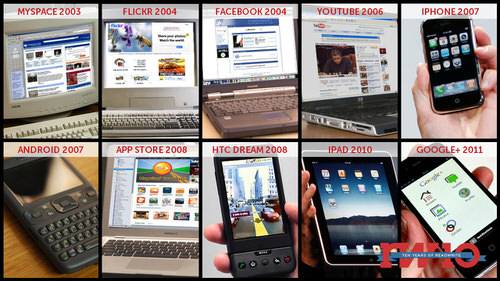
ReadWrite celebrates its 10th anniversary on Saturday, April 20, 2013. For the occasion, we’re running a series of articles looking back—and looking forward.
Ten years ago, I published the first post on this weblog. Entitled simply “The Read/Write Web,” it was a manifesto of sorts. The first era of the Web, from the 1990s to the early 2000s, had been largely read-only. It was stuck in the old broadcast model: professionals published the content, the rest of us merely read it.
But in 2002 and 2003, I could sense that a sea change was near. Tools were being developed that empowered everyone—including me—to publish to the Web.
“The goal now is to convert the Web into a two-way system,” I wrote in that debut post. “Ordinary people should be able to write to the Web, just as easily as they can browse and read it.”
ReadWrite’s Predictive Powers
Well, that goal was well and truly achieved! While nobody could have predicted in 2003 the scale of innovation that would occur, I’m proud that over the years ReadWrite did predict many technologies that people take for granted today.
For example, I remember writing a lot about the Web Office over the first five years of this blog. In our end-of-year predictions post in 2006, I wrote: “The consumerization of the enterprise trend will start to infiltrate corporate IT, in the form of Web-based office apps and more collaborative systems.” Scan your typical office in 2013 and you will see Google Docs, corporate versions of Twitter, Evernote Business, and many more applications that came from the consumer world.
Also look at the rise of Amazon Web Services, a cloud-computing platform from the online retailer that was well ahead of its time and which we wrote about extensively (mostly thanks to Alex Iskold, one of our earliest feature writers).
Our 2006 predictions post stated:
“We also think there will be moves toward an Amazon-like web services stack from other players, particularly Google. For example Google may want to catch up with Amazon’s S3 – EC2 services. And where Google goes, you can expect Microsoft to go too.”
Since 2006, not only have Google and Microsoft created cloud-computing platforms, but so have Apple, Oracle, HP, Rackspace and many other companies.
I’m also proud that ReadWrite wrote about some trends long before they became popular. For example, The Internet of Things—when real-world objects get connected to the Internet. ReadWrite was the only tech blog exploring that trend back in 2009, when only a few brave developers and startups were building consumer products. Fast forward to 2013 and the market for Internet-connected cars, thermostats, security systems, watches and other real-world objects is thriving.
A Decade of Astounding Innovation
In April 2003, I was an unknown 31-year old website manager from New Zealand, about as far away from Silicon Valley as you can get. I may not have been in the right place, but I was certainly at the right time. Over the next ten years, I got to explore and help chronicle the emergence of first the Social Web (2003-2005), then the Mobile Web (2007-2008)—arguably the two biggest waves of technology innovation over the past decade.
ReadWrite has witnessed—and written about—the creation of many revolutionary technologies:
- MySpace, the first mass-market social network, launched in August 2003.
- Flickr, which became the leading photo-sharing website of the era, launched in February 2004.
- Facebook launched to Harvard students in February 2004 and eventually opened to the wider public in September 2006.
- YouTube, the video-sharing phenomenon, opened as a beta site in May 2005.
- Twitter was created in 2006 and had its first tipping point in March 2007 at SXSW.
- The iPhone was unveiled by Steve Jobs in January 2007.
- Google announced its open-source mobile operating system, Android, in November 2007.
- Apple launched the App Store in July 2008.
- The first Android phone, the HTC Dream, was released in October 2008.
- The iPad was released in April 2010.
- Google+ launched in June 2011.
Here’s To The Next Decade!
When I started ReadWrite in 2003, the Web was primarily about what was happening on your home computer. And as outlined above, a lot of innovation happened in that era of the Web—Flickr, YouTube, Facebook and more.
But today, the Internet is everywhere. As Owen Thomas wrote in his introductory post as ReadWrite’s new editor-in-chief, the Internet is now in our pockets, on our bodies, scattered around the physical world. So I’m thrilled that the blog I founded will chronicle this new era of the Read/Write Web—a world where everything is read/write.
Photo composite by Madeleine Weiss.










